Ever notice those black and orange, almost red, bugs hanging around your yard during the late summer or early fall season? They are hard to miss as they usually appear in large, unstructured congregations. If you’re unlucky, they may even get into your house.
They are boxelder bugs, which are named after living in and thriving on boxelder trees. Boxelder bugs are flattened insects that are half an inch long and are considered nuisance pests as they leave stains on light-colored surfaces, as well as cause deformation and discoloration of the plants they consume.
Learn more about boxelder bugs, their appearance, diet preferences, why you have them in your yard or home, what you can do to get rid of them, and other interesting information on them by reading this article!
What Are Boxelder Bugs?
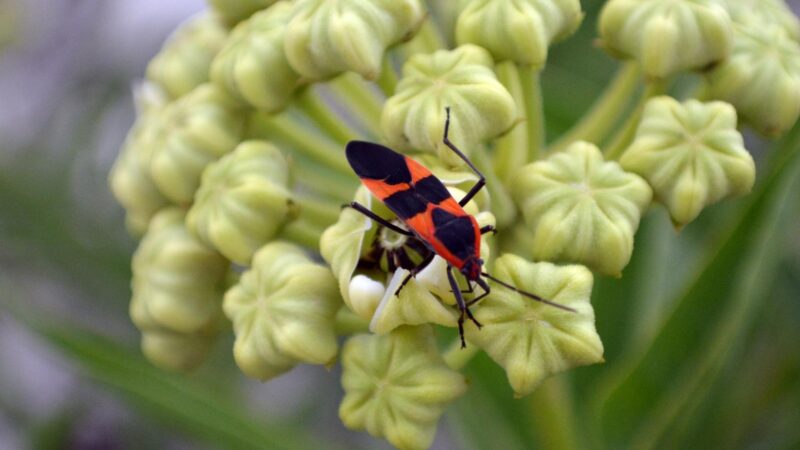
Boxelder bugs (Boisea trivittata) belong to the family Rhopalidae or scentless plant bugs. Native to the Western and Southwestern U.S., they are named after their natural habitat and food preference, which are boxelder trees found in mixed and deciduous forests. During the late fall season, however, they will seek warmer areas to hibernate in, such as buildings and windows.
These bugs are considered social and like to live in large, unstructured groups. They constantly feed during the spring and summer seasons to store enough body fat to survive through winter, wherein they hibernate and do not feed at all.
What Do Boxelder Bugs Look Like?
Boxelder bugs have flat and elongated bodies that are either black or brownish-black with reddish markings found on the edges of their forewings, sides, and center of their pronotum (a plate covers their thorax) and end margins of their abdominal segments. Their eyes and first leg segment are also red in coloration.
When they are about halfway into full development, boxelder bugs will acquire their characteristic body coloring. Moreover, males have smaller abdomens than females and have a less rounded rear part. Both sexes, however, are half an inch long on average.
What Do Boxelder Bugs Eat?
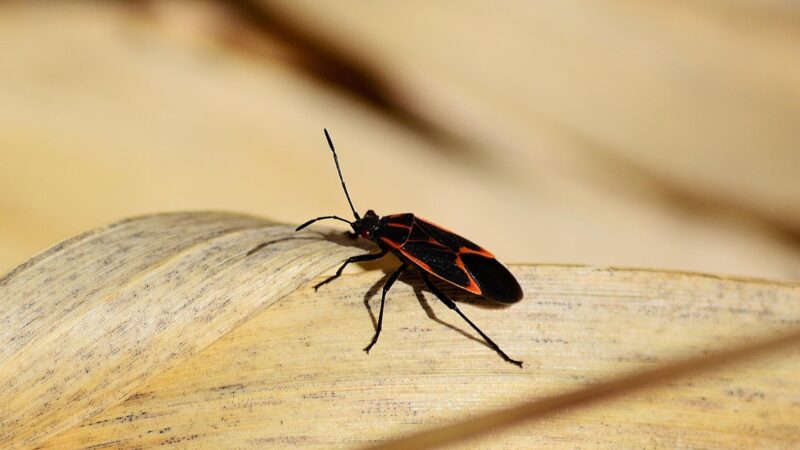
Adult boxelder bugs feed on the twigs, flowers, leaves, and seeds of their host plants, which are primarily boxelder trees, ash trees, and maple trees. Nymphs consume the juices of the seeds of their host plants.
During their molting stage, boxelder bugs may tend to eat other boxelder bugs or eggs. They also feed on fruits such as plums, apples, peaches, pears, and grapes.
Feeding is usually done throughout the spring and early summer seasons. A few weeks after feeding, they will begin mating and move to female seed-bearing boxelder trees around mid-July.
Do Chickens Eat Boxelder Bugs?
Chickens can eat boxelder bugs, but not often. They are usually fed a diet that is mixed with a small number of insects. Boxelder bugs are added to the mix if other more desirable insects are in low supply.
However, chickens don’t particularly enjoy them compared to other insects, such as potato bugs, grasshoppers, crickets, and squash bugs.
Do Boxelder Bugs Live In the Ground?
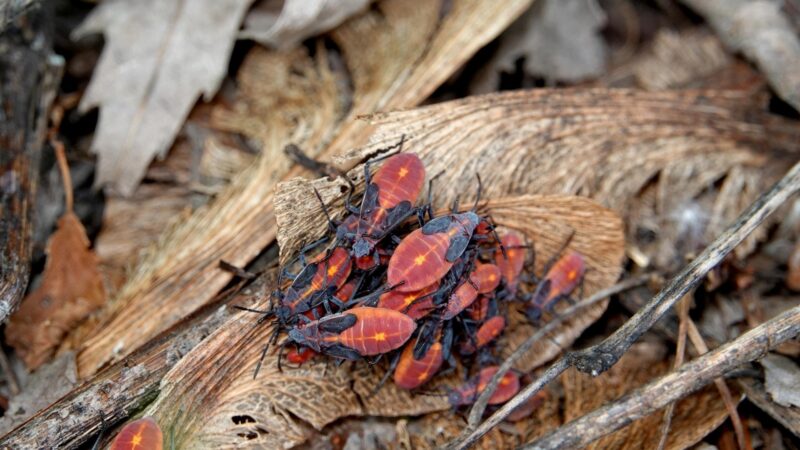
Boxelder bugs can be seen foraging for fallen seeds on the ground or low vegetation and feeding on them, especially nymphs during the summer season. However, the bugs seek shelter on the tree itself, specifically beneath the tree’s bark.
At the end of the summer season or when the fall season starts, the bugs will leave the trees to seek warm, protected areas for winter, such as homes and buildings, particularly in the interiors, spaces, and cracks.
Are Boxelder Bugs a Problem?
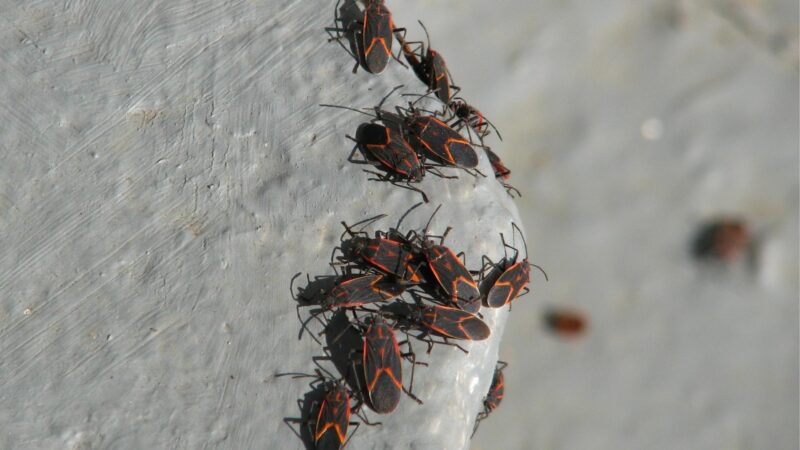
Boxelder bugs are a problem, as they are nuisance pests, especially in the spring and autumn season when they group in large numbers on the sides of houses, trees, and buildings.
As the weather further cools down, boxelder bugs will push themselves into spaces and cracks around homes to enter the warmer living area. They can also be found around windows and in walls and attics.
If left unattended, they will stay there until the weather is warm enough for them to go out again.
Damage caused by boxelder bugs to boxelder trees is barely noticeable. However, if infestations are heavy, they can cause minor deformities and discoloration.
With regards to homes and buildings, they can stain surfaces that are light-colored as they release their feces into them. Killing the bugs by smashing them can also trigger the release of an unpleasant smell.
What Attracts Boxelder Bugs in Your Yard?
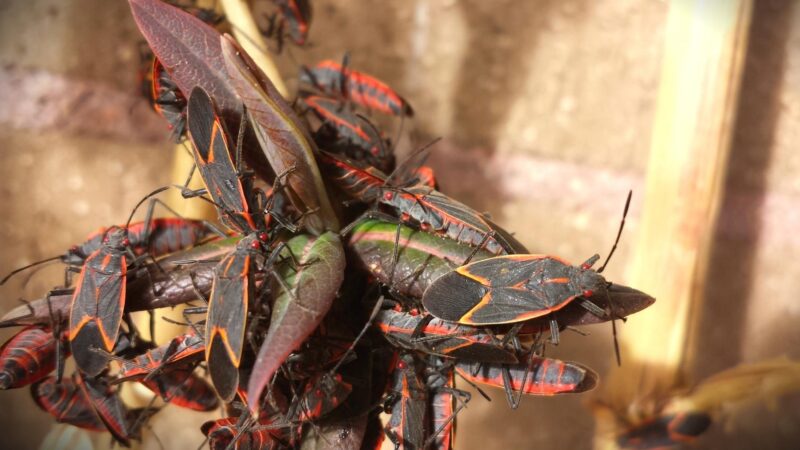
Boxelder bugs may be attracted to your yard if it has suitable conditions for the bugs to thrive in, namely: the presence of yard debris such as leaves, piles of wood, and rocks for them to hide under and the fact that your yard may be warm enough for them to thrive in during cold weathers.
Why Do I Have Boxelder Bugs in My House?
This is because they want to stay warm during the winter season or when the weather is too cold for them to handle, and your house is a good place to provide them with the insulation they need.
They will particularly stay in attics, around windows, on walls, and in other warm living areas.
Boxelder bugs are also particularly attracted to tall buildings or structures that are standing alone on flat ground. Color doesn’t matter to them, only height, as they will investigate the warmth the building provides.
How Long Do Boxelder Bugs Hang Around?
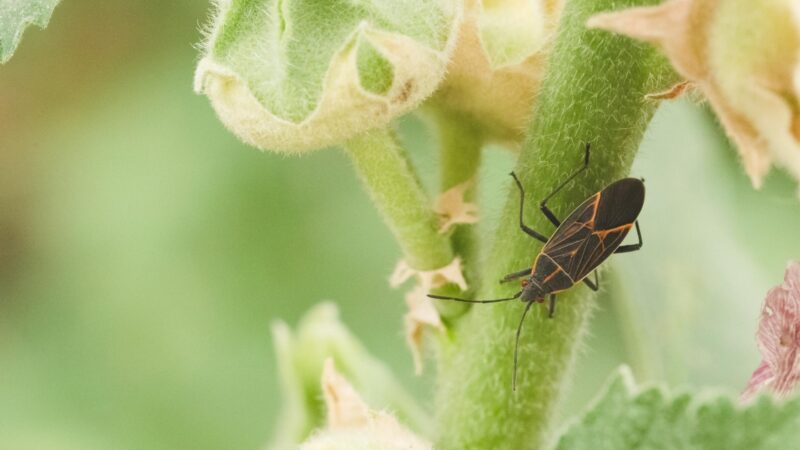
Boxelder bugs live for about a few days to a week after they begin to seek the warmth of homes and buildings by late summer or early fall. However, some can live long enough to escape after the winter season ends.
Boxelder bugs will remain generally inactive throughout the winter season as they hibernate.
As the temperature both indoors and outdoors becomes warm enough, they will wake from hibernation and move towards windows and other areas that have sunlight. However, the bugs do not become active at the same time, and not all of them can be reached by warmth.
By springtime, all boxelder bugs that have survived by overwintering will become fully active and try to escape the homes and buildings they are in. Some might not make it outside as they become trapped and will eventually die since they cannot thrive or reproduce in homes.
What Do Boxelder Bugs Hate?

Like other bugs, boxelder bugs hate the scent of essential oils, such as lavender, thyme, peppermint, tea tree, citronella, lemongrass, clove oil, cinnamon oil, and eucalyptus. They can also be repelled by citrus fruits (e.g. lemon and lime) and vinegar.
How Do I Get Rid of Boxelder Bugs in My House?
Remove boxelder bugs with a vacuum or by using a broom and a dustpan. Handpicking and disposing of them outside is also an option, but you have to make sure you get rid of them thoroughly, or else they would come back indoors again. You can find them in ceiling lights, doors, around house water plants, windows, vents, faucets, and along sidings.
Prevent them from entering your home by sealing all potential entry points right before the start of fall, around the end of August. Consider repairing any damaged spaces and seal those that you can using caulk, a rubber seal, copper mesh, and other appropriate sealants.
Although it is not generally recommended, you can try purchasing insecticides that have one of the following as the active ingredient: permethrin, bifenthrin, lambda-cyhalothrin, cyfluthrin, and deltamethrin. Spray if you have heavy infestations indoors. However, it is best to contact pest control services in this situation.
How Do I Get Rid of Boxelder Bugs in My Yard?
Eliminate plant debris such as piles of wood, fallen leaves, branches, and other plant materials that boxelder bugs can hide under. Clear away any fallen seeds near and beneath trees. Vacuum or sweep driveways and patios to further clean the surroundings.
Consider removing boxelder trees, especially the female pod-bearing ones as they are the primary source of food for the bugs. However, this method won’t completely eradicate the bugs as they are known to travel several distances away.
Insecticidal sprays can be used for heavy outdoor infestations. Specifically, pyrethroid insecticides that are sprayed against tree trunks can help reduce populations.
What Home Remedy Kills Boxelder Bugs?
Create a boxelder bug spray out of 4 tablespoons of dishwashing soap mixed with a gallon of water and directly spray onto the bugs to kill them. You can also try using vinegar and mixing it in a 1:1 ratio with water.
When you want to use essential oils, choose any of the abovementioned, squeeze 20 drops of it into alcohol, and combine it with a gallon of water. For increased potency, you can mix 2 ounces of any vinegar of your choice.
Does Peppermint Oil Repel Boxelder Bugs?
Peppermint oil can repel boxelder bugs. You can mix 20 drops of peppermint oil with alcohol and a gallon of water and use it to spray against boxelder bugs. You can also try mixing it with other essential oils or vinegar and citrus fruits to increase its effectiveness.
Insecticides for Boxelder Bugs
Keep in mind that insecticides are usually the last resort when getting rid of boxelder bugs. This is because they are relatively easy to kill and do not need the use of chemicals. However, in cases of heavy infestations, insecticides can be your only choice.
Look for insecticides that have any of the following as their active ingredient: bifenthrin, permethrin, cyfluthrin, lambda-cyhalothrin, and deltamethrin. For more information on publicly available insecticides, check out this link.
Boxelder bugs are black and orange bugs that can cause damage to boxelder trees and stain light-colored surfaces if left untreated. Getting rid of them requires the use of essential oils, citrus fruits, or vinegar. For the best results, you can mix all three. Prevent them from entering your premises by sealing any possible entry points.
List of Sources
Baker, J. (2019). Boxelder Bugs in the Landscape. N.C. Cooperative Extension.
Flowers-Kimmerle, N. (2016). Boxelder Bugs. University of Illinois Urbana‐Champaign.
Hahn, J., Ascerno, M. (2018). Boxelder bugs. University of Minnesota Extension.
Boxelder Bug. (2021). Iowa State University Extension and Outreach.
Boxelder Bug . Michigan State University.
- How to Get Rid of Copperheads | Practical Guide - August 27, 2023
- How to Get Rid of Corn Snakes | What Makes Them Aggressive? - August 27, 2023
- How to Get Rid of Alligators | Safety Measures and Removal Methods - July 16, 2023
